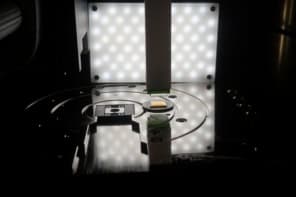
A new giant organic molecule that is shaped like rotelle or wagon-wheel pasta has been created by an international group of researchers. The molecule is known as a “pi-conjugated spoked-wheel macrocycle” and emits light that has no overall polarization, according to the team. This feature could be useful for making more efficient organic light-emitting diodes (OLEDs) – however, the researchers say that much more work has to be done before there are any practical applications.
Currently, OLEDs are used in energy-saving light bulbs and as displays in televisions and mobile phones. They offer high pixel brightness, wide viewing angle, very high contrast ratio, fast response times and low power consumption. OLEDs have the potential to be even better but scientists have struggled to further boost their performance because of losses caused by the polarization of light as it passes through the devices.
Polarized loss
The problem is related to the difference in the refractive indices of the organic layer of an OLED and the adjacent glass layer. The result is a waveguide effect in the organic layer that prevents much of the light from escaping. This effect depends on the polarization of the light and this inspired John Lupton and colleagues at the University of Utah in the US along with other researchers in Germany to create wheel-shaped molecules to depolarize the light.
It’s just the beauty of making a perfectly symmetrical system and then watching how the symmetry is broken spontaneously
John Lupton, University of Utah
Lupton explains that current OLEDs are made up of spaghetti-shaped chain polymers that tend to emit polarized light. As a result, nearly 80% of the light generated remains trapped within the organic layer. In the spaghetti-shaped chain polymers, polarized light is produced by electrons that can only oscillate by moving up and down the chain. However, in the new wagon-wheel-shaped polymers the electrons can oscillate in all directions, creating light that is not polarized, reducing the losses associated with wave-guiding.
Perfect wagon wheels
The molecules were made by team member Sigurd Höger from Bonn University in Germany. Lupton told physicsworld.com that the polymers were challenging to make because they are so large – each one is 6 nm wide. He adds that the molecules retain their shape over time and there are no isomers. Indeed, it is their perfectly symmetrical shape that scrambles the polarization of the light. Lupton likens it to balancing a perfectly sharp pencil tip – in an ideal experiment, the pencil will fall in a different direction every time. “Every time you excite the ring, a photon is emitted from a different, random segment of the ring,” he explains.
The team then carried out single-molecule experiments, where it shone ultraviolet light on ring molecules to generate visible light photons. The photons had a “scrambled” polarization – one that changes randomly from photon to photon. The large ring-shaped molecules can “catch” other molecules, making them effective biological sensors. They also have potential use in solar cells and switches, according to the team.
Lupton is quick to point out that the new work is purely basic research so far – the team has only made the new ring-like molecules and has not yet tested them in an OLED. “The polarization scrambling is at present more of an academic curiosity. We cannot really claim whether this is terribly useful or not,” says Lupton. “It’s just the beauty of making a perfectly symmetrical system and then watching how the symmetry is broken spontaneously.”
The research is published in Nature Chemistry.



